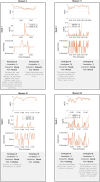Capturing spontaneous interactivity: a multi-measure approach to analyzing the dynamics of interpersonal coordination in dance improvisation
- PMID: 39564586
- PMCID: PMC11575498
- DOI: 10.3389/fpsyg.2024.1465595
Capturing spontaneous interactivity: a multi-measure approach to analyzing the dynamics of interpersonal coordination in dance improvisation
Abstract
Introduction: Interpersonal coordination is widely acknowledged as critical to relating with, connecting to, and understanding others, but the underlying mechanisms of this phenomenon are poorly understood. Dance-particularly improvised dance-offers a valuable paradigm for investigating the dynamics of interpersonal coordination due to its inherent ability to connect us. However, conventional approaches to studying coordination often fail to capture the co-creative spontaneity that is intrinsic to such interactions.
Methods: This study combined multiple measures of interpersonal coordination to detect moments of high coordination between two freely improvising dancers. We applied maximum correlation vectors, normalized Symbolic Transfer Entropy (NSTE), and surveys to analyze the time-varying dynamics of similarity in movement speeds, directed influence, and subjective perception of dancers engaged in an improvisation task.
Results: This multi-measure approach offers a means of capturing the interplay between different dimensions of interpersonal coordination.
Discussion: This approach may be used to understand the underlying mechanisms of co-creative social interactions in improvised dance and other forms of spontaneous interactivity.
Keywords: coordination dynamics; interactional synchrony; movement; pose estimation; social interaction; symbolic transfer entropy; video analysis.
Copyright © 2024 Whitehead, De Jaegher, Santana, Todd and Blain-Moraes.
Conflict of interest statement
The authors declare that the research was conducted in the absence of any commercial or financial relationships that could be construed as a potential conflict of interest.
Figures







References
-
- Bernieri F. J., Rosenthal R. (1991). “Interpersonal coordination: behavior matching and interactional synchrony” in Fundamentals of nonverbal behavior. Studies in Emotion & Social Interaction. eds. Feldman R. S., Rimé B. (New York, NY: Cambridge University Press; ), 401–432.
-
- Boker S. M., Rotondo J. L. (2002). “Symmetry building and symmetry breaking in synchronized movement” in Advances in consciousness research. eds. Stamenov M. I., Gallese V. (Amsterdam: John Benjamins Publishing Company; ), 163–171.
-
- Chang S. M. (2018). Cognitively deconstructing musical free improvisation to inform on performance and applied improvisation. Vancouver, BC: University of British Columbia.
LinkOut - more resources
Full Text Sources
Miscellaneous

